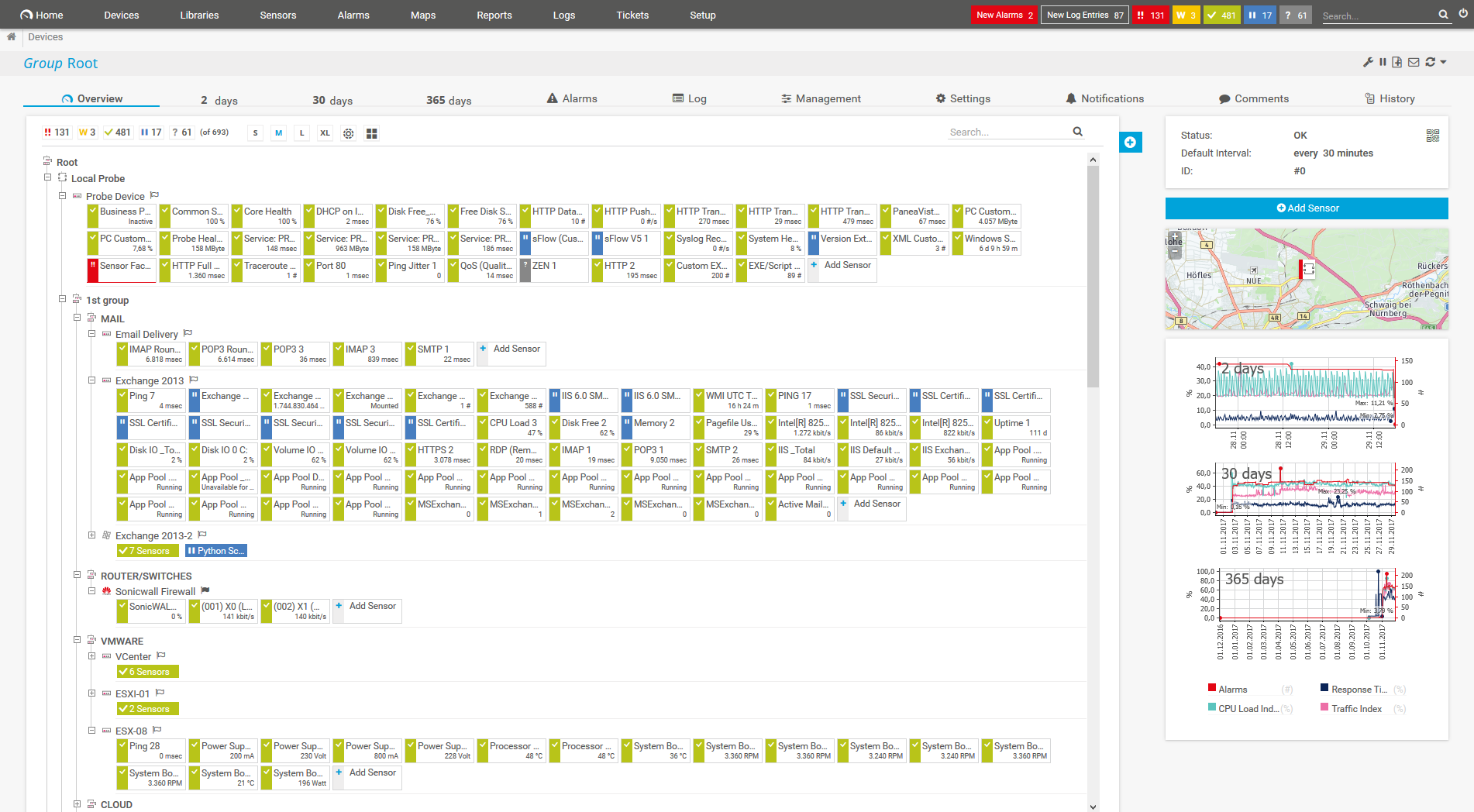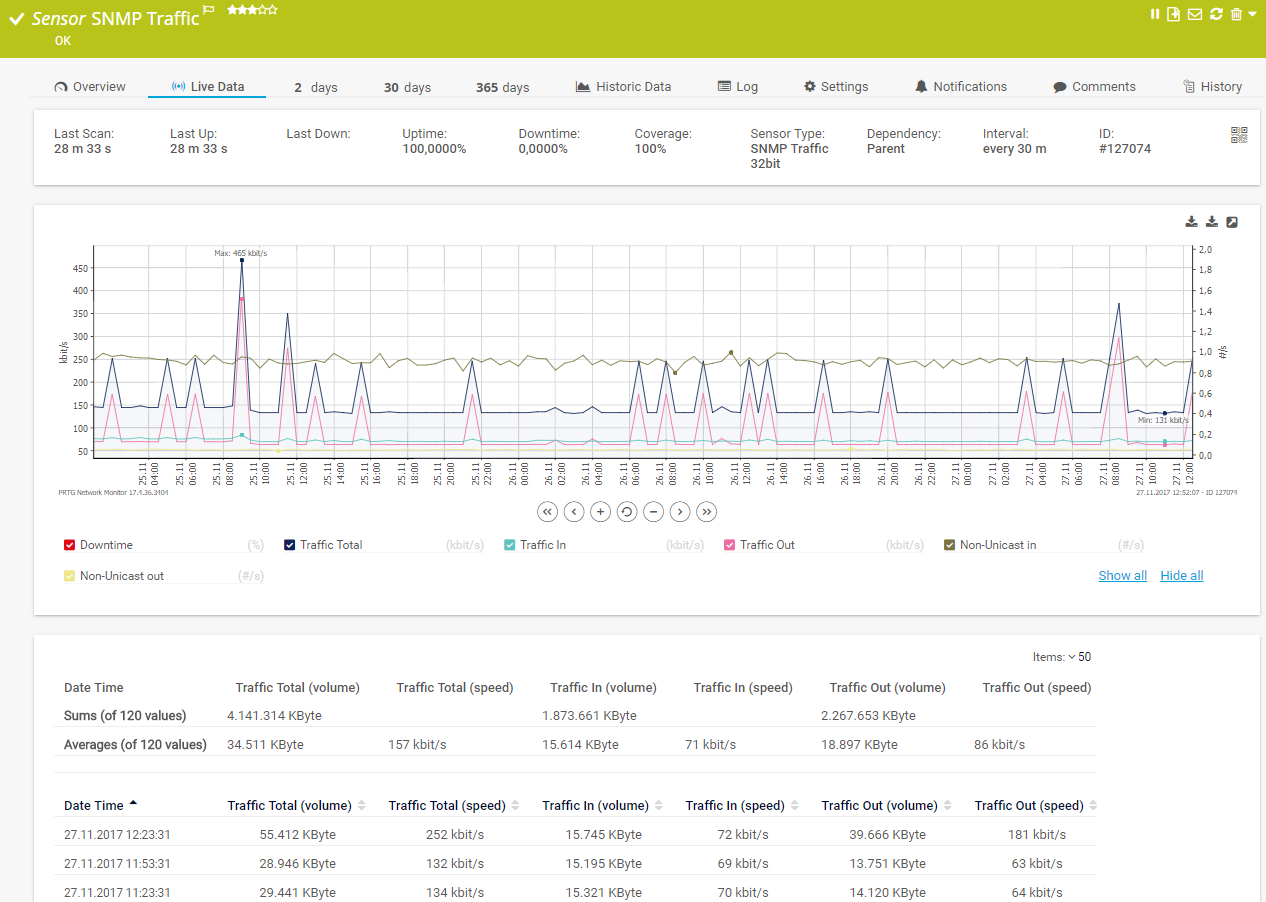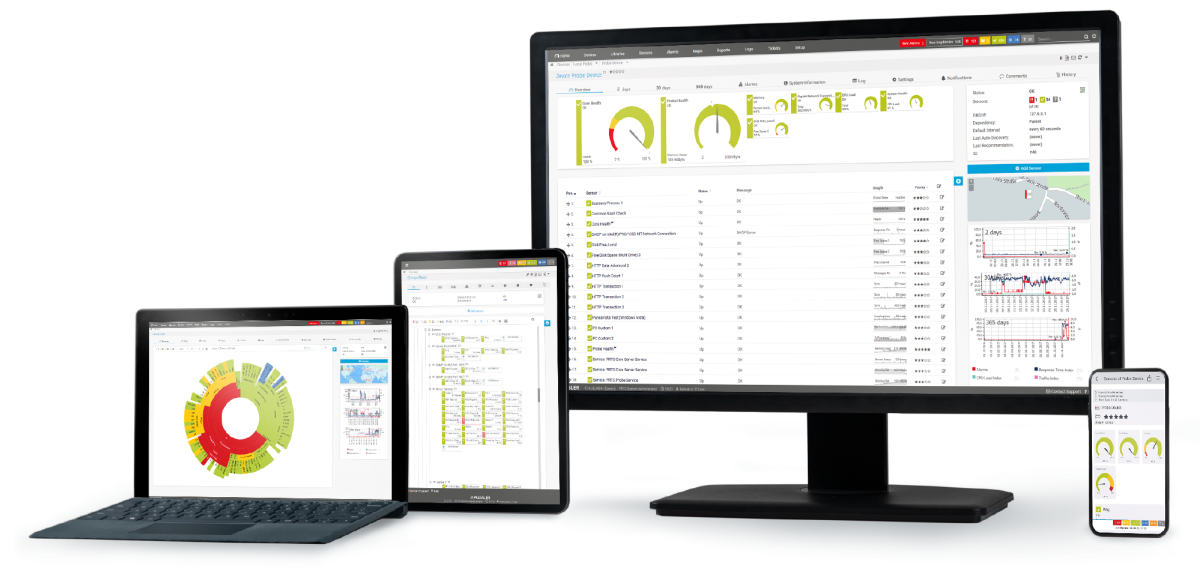Custom alerts and data visualization let you quickly identify and prevent all kinds of network issues.
Need in-depth data analysis of health and performance metrics across a complex, distributed network? Or do you simply want basic monitoring capabilities?
It doesn’t matter. Paessler PRTG can do both with equal ease.
And, more importantly, with minimal tweaking. From granular application performance monitoring data, log collection and log analytics, and integrations with observability tools like OpenTelemetry, Prometheus, and Grafana, to tracking run-of-the-mill metrics like bandwidth, memory, and CPU load.
Because monitoring tools — even in complex environments — are best when they’re simple and user-friendly. Wouldn’t you agree?
Set it once and adjust when needed (or forget about it completely).
PRTG’s powerful automations, preconfigured and custom sensors, and out-of-the-box functionality make the process of monitoring, troubleshooting, optimizing, and capacity planning easier than you could’ve ever imagined.
Quick installation with automatic network discovery and smart setup for instant monitoring
Custom dashboard creation via drag & drop with easy-to-read visualized overviews
Different user interfaces for web, desktop, and mobile apps for monitoring on the go
Network of qualified implementation partners to support you with a smooth migration to PRTG
Diagnose network issues by continuously tracking the health, availability, and performance of your entire IT infrastructure. Show hardware parameters, application performance, network traffic, bandwidth usage, and other key metrics in real time. Visualize data in clear graphs and dashboards to identify problems more easily. Gain the overview you need to troubleshoot all kinds of issues in your network.

Device tree view of the complete monitoring setup

Custom PRTG dashboard for keeping an eye on the entire IT infrastructure

Live traffic data graph in PRTG
FEATURE | PRTG PRTG | Splunk Splunk |
|---|---|---|
One tool for your entire network | PRTG All monitoring features included | Splunk Available features depend on which plan you're on |
Easy setup, intuitive monitoring | PRTG User-friendly interfaces for web, desktop, and mobile | Splunk Requires some manual configuration |
Automatic network discover | PRTG Included | Splunk Included |
Real-time alerts & notifications | PRTG Advanced, highly customizable alerting via different notification methods | Splunk Supported |
Custom maps & dashboards | PRTG Custom dashboard creation via drag & drop | Splunk Supported, but requires significant technical input |
Agentless monitoring | PRTG No need to install agents on the monitored systems | Splunk Supported |
On-premises or cloud-based | PRTG Flexible deployment options available | Splunk Both on-premises and cloud-based deployments supported |
Enterprise version | PRTG Available | Splunk Available |
Freeware version | PRTG Available for up to 100 sensors, free for life | Splunk Not available |
Distributed network monitoring | PRTG Monitoring an unlimited number of remote locations included | Splunk Supported, but requires significant technical input |
Server & application monitoring | PRTG Out-of-the-box integration, no extra cost | Splunk Supported, but requires significant technical input |
Network performance monitoring | PRTG Out-of-the-box integration, no extra cost | Splunk Supported, but requires significant technical input |
Bandwidth monitoring | PRTG Out-of-the-box integration, no extra cost | Splunk Supported, but requires significant technical input |
Network traffic analyzer | PRTG Out-of-the-box integration, no extra costs | Splunk Supported, but requires significant technical input |
Cloud services monitoring | PRTG Out-of-the-box integration, no extra cost | Splunk Supported, but requires significant technical input |
Virtual infrastructure monitoring | PRTG Out-of-the-box integration, no extra cost | Splunk Supported, but requires significant technical input |
Storage resource monitoring | PRTG Out-of-the-box integration, no extra cost | Splunk Supported, but requires significant technical input |
Database monitoring | PRTG Out-of-the-box integration, no extra cost | Splunk Supported, but requires significant technical input |
Web performance monitoring | PRTG Out-of-the-box integration, no extra cost | Splunk Supported, but requires significant technical input |
Supports leading technologies | PRTG SNMP, flow protocols, packet sniffing, WMI, HTTP, ping, SQL, and much more | Splunk SNMP, HTTP/S, SSH, and other leading technologies supported |
Create your own scripts | PRTG Own PRTG API included for custom sensors and scripts | Splunk Supported, but requires significant technical input |
Includes technical support | PRTG Expert support included, no extra costs | Splunk Paid support only |
Download. Set. Go.
No need to spend months studying product documentation, or reading up on specialized forums, just to get to grips with the basics. Whether you use it out of the box or customize it, PRTG feels instantly familiar, and adapts to your requirements in a few clicks.
Key in an IP address range, and PRTG will take it from there — finding all connected devices, assigning the appropriate sensors, collecting data, and even setting default performance and alert thresholds for you. Once that's done, you can leave it as is or come back to it later to tailor it to your exact requirements.
Routers. Servers. Firewalls. APM. AWS and Azure. Data volumes. Log management. Kubernetes. Kibana and your underlying elastic stack. With 250+ preconfigured sensors, plus the ability to create your own, and support for unlimited local and remote devices, data collection and monitoring capabilities don’t get more comprehensive than this.
We've designed PRTG to give you the most seamless user experience possible. Customizable templates and a drag and drop interface make the process of tailoring your monitoring environment quick and painless. And our friendly support team are always on hand to help if you get stuck. Yes, even if you're on the free plan.
You shouldn't need a PhD to understand a SaaS vendor's pricing structure. PRTG keeps things simple, transparent, and cost-effective: pay for a batch of sensors, with the first 100 free. Which means that, if you're a startup, you can set up a fully-featured monitoring environment without paying anything, and expand it as you grow.
You are interested to know if PRTG could be an alternative to your Splunk implementation?
PRTG is set up in a matter of minutes and can be used on a wide variety of mobile devices.

We also compared PRTG with other monitoring tools:
Prometheus is an open-source tool that excels at monitoring containerized applications. However, it lacks comprehensive network monitoring capabilities and requires extensive manual configuration for infrastructure visibility.
OpenNMS is hard to beat for flexibility and configurability, but making the most of it requires time, patience, and expertise. PRTG is just as powerful and offers a high level of customization, but it's much quicker and easier to set up.
Netreo offers configurability but is resource-heavy and requires manual tweaking. PRTG is powerful, flexible, works out of the box, and has budget-friendly pricing.
Icinga is an open-source monitoring tool offering flexibility but requiring advanced technical knowledge. Its setup and maintenance can be complex, especially for teams lacking dedicated Linux expertise.
Real-time notifications mean faster troubleshooting so that you can act before more serious issues occur.
Partnering with innovative IT vendors, Paessler unleashes synergies to create
new and additional benefits for joined customers.
Combining PRTG’s broad monitoring feature set with IP Fabric’s automated network assurance creates a new level of network visibility and reliability.
A combination of Orchestra and PRTG provides the ideal solution to monitor the traditional IT Infrastructure as well as the central communication server in hospitals and industrial environments.
Paessler PRTG integrates Wago systems into the higher-level monitoring of IT, security and production systems, thus creating a central overview.
Network Monitoring Software – Version 25.3.110.1313 (August 27, 2025)
Download for Windows and cloud-based version PRTG Hosted Monitor available
English, German, Spanish, French, Portuguese, Dutch, Russian, Japanese, and Simplified Chinese
Network devices, bandwidth, servers, applications, virtual environments, remote systems, IoT, and more
Choose the PRTG Network Monitor subscription that's best for you
Choosing between Paessler PRTG and Splunk depends on several factors, such as your specific network monitoring needs, budget, and technical resources available in your organization.
PRTG is ideal:
Splunk might be your choice:
The answer to this depends on the use cases you have in mind.
If having access to an observability tool with high-cardinality, high-dimensionality datasets is a priority, Splunk is the way to go. Splunk enables you to monitor, correlate, and analyze virtually any metric, log, or trace, including those that aren't directly tied to specific hardware or software assets, and also uses machine learning and AI-powered analytics. The trade-off is that it requires extensive technical configuration to get it working just the way you want it.
PRTG, on the other hand, is an all-rounder with built-in automation, designed to simplify network and infrastructure monitoring, troubleshooting, and optimization.
Any network monitoring solution will require some manual configuration, especially if you have large IT infrastructure or need complex monitoring capabilities. That said, setting up PRTG is a quick, simple, and intuitive process, especially compared to Splunk.
Whether you choose PRTG Hosted Monitor — our cloud-native solution — or our on-premise solution PRTG Network Monitor (or a hybrid cloud setup), Auto-Discovery will do most of the work. Key in an IP address range and it will detect every device within that range, assign the appropriate sensors, and start monitoring.
Splunk, on the other hand, requires manual configuration — data inputs, forwarders, indexing… you get the picture — and the technical know-how to pull it off. Great if you're comfortable with this kind of stuff, not so much if you don't have the expertise or resources to do it.
The short answer: PRTG's pricing is more transparent, more predictable, and well, just simpler and more straightforward.
The longer answer. PRTG uses sensor-based pricing, with the first 100 sensors free, for life. All features and functionalities are included in the base price, even on the free plan. This means you don't pay to access specific features, or depending on whether you want to deploy PRTG’s network monitoring software on-premises or in the cloud. You pay for the metrics you want to monitor. And, you can get started at no cost.
Splunk, on the other hand, has four different pricing models, with none of them having a free tier:
● Workload pricing
● Ingest pricing
● Entity pricing
● Activity-based pricing
How do these work, and what's the difference between them? Well, Splunk has a three-page brochure to explain the first three pricing models, plus two landing pages with further explanations. Compare that to our 70-word overview above, and reach your own conclusions.
In PRTG, “sensors” are the basic monitoring elements. One sensor usually monitors one measured value in your network, for example the traffic of a switch port, the CPU load of a server, or the free space on a disk drive. On average, you need about 5-10 sensors per device or one sensor per switch port.
Paessler conducted trials in over 600 IT departments worldwide to tune its network monitoring software closer to the needs of sysadmins. The result of the survey: over 95% of the participants would recommend PRTG – or already have.
You are interested to know if PRTG could be an alternative to your Splunk implementation?